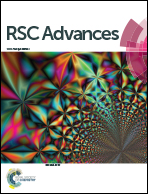Non-covalent hydrophilization of reduced graphene oxide used as a paclitaxel vehicle
Abstract
Graphene oxide (GO) and reduced graphene oxide (RGO) are attractive materials due to their potential biomedical applications, especially as drug delivery vehicles because of their huge specific surface area. In the current study, GO and RGO were prepared. In addition, a perylene derivative, phosphorylcholine oligomer grafted perylene (Perylene-PCn), was synthesized following the atom transfer radical polymerization procedure. In order to determine their structures, the products were characterized carefully with Fourier transform infrared spectra, proton nuclear magnetic resonance, X-ray photoelectron spectroscopy, wide angle X-ray diffraction, thermogravimetric analysis, and atomic force microscopy etc. The properties including fluorescence and biocompatibility were also evaluated. Utilizing the π–π stacking interaction of RGO and the perylene moiety, water dispersible RGO/Perylene-PCn composites were fabricated and then investigated as a vehicle for anti-tumor paclitaxel (PTX). The anti-tumor effects of free PTX and PTX@RGO/Perylene-PCn were compared with an in vitro cytotoxicity assay. The results demonstrated that RGO/Perylene-PCn can be used as an anti-tumor agent delivery vehicle for potential oncology applications.


 Please wait while we load your content...
Please wait while we load your content...